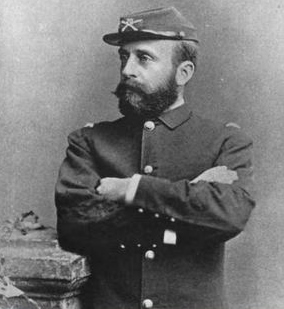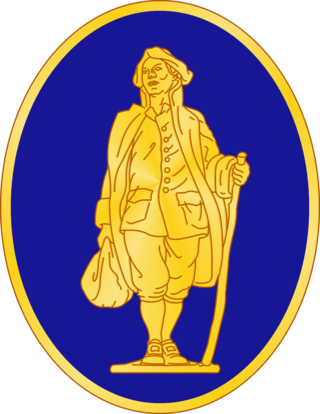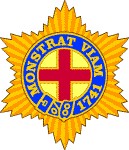
The Pennsylvania Army National Guard, abbreviated PAARNG, is part of the United States Army National Guard and is based in the U.S. Commonwealth of Pennsylvania. Together with the Pennsylvania Air National Guard, it is directed by the Pennsylvania Department of Military and Veterans Affairs. The PAARNG maintains 124 armories and is present in 87 communities across the Commonwealth.

The 7th Regiment of the New York Militia, aka the "Silk Stocking" regiment, was an infantry regiment in the Union Army during the American Civil War. Also known as the "Blue-Bloods" due to the disproportionate number of its members who were part of New York City's social elite, the 7th Militia was a pre-war New York Militia unit that was mustered into federal service for the Civil War.

The 3rd Pennsylvania Reserve Regiment, also known as the 32nd Pennsylvania Volunteer Infantry Regiment, was an infantry regiment that served in the Union Army during the American Civil War. It was part of the 2nd Brigade of the Pennsylvania Reserves division.

Sylvester Bonnaffon Jr. was a United States soldier who fought with the Union Army during the American Civil War as a first lieutenant with Company G of the 99th Pennsylvania Infantry. He received his nation's highest award for valor, the U.S. Medal of Honor, for his gallantry and leadership against Confederate troops during the Battle of Boydton Plank Road, Virginia on October 27, 1864. That award was conferred on September 29, 1893.

The 111th Infantry Regiment, was originally the Pennsylvania Militia or "Associators" that fought in the American Revolution, composed of civilian males from the citizenry of Pennsylvania. It is one of several National Guard units with colonial roots and campaign credit for the War of 1812. The Pennsylvania Militia often fought in conjunction with General Washington and the Continental Army along the Delaware River. Today the idea of a Pennsylvania Militia is represented in the U.S. Army by 1st Battalion, 111th Infantry assigned to the Pennsylvania Army National Guard's 56th Stryker Brigade Combat Team, 28th Infantry Division. The regiment, founded as the Associators by Benjamin Franklin in Philadelphia, Pennsylvania on 21 November 1747, is the oldest regiment in Pennsylvania.

The First Corps of Cadets of Massachusetts formed in 1741. Its motto is Monstrat Viam - "It Points the Way." While it has served in several wars, the sub-unit's primary contribution to Massachusetts and to the United States was as an officer-producing institution for new regiments from the Revolutionary War through World War II.

The 175th Infantry Regiment is an infantry regiment of the Maryland Army National Guard. It is one of several National Guard units with colonial roots and campaign credit for the War of 1812.
Turner Gustavus Morehead (1814–1892) was an officer in the Mexican–American War and American Civil War and Brevet Brigadier General in the Union Army.

Washington Grays Monument, also known as the Pennsylvania Volunteer, is a bronze statue by John A. Wilson. The monument represents the Washington Grays who served in the 17th, 21st and 49th Pennsylvania Militia during the American Civil War. In 1925, almost 20 years after the sculpture was made, renowned sculptor and art historian Lorado Taft wrote, "No American sculpture has surpassed the compelling power which John A. Wilson put into his steady, motionless 'Pennsylvania Volunteer'." Joseph Wilson built the base of the monument which was unveiled on April 19, 1872. Over 35 years later John Wilson sculpted the bronze statue, which was dedicated on April 18, 1908 at Washington Square, and rededicated June 14, 1991 at its present location in front of the Union League of Philadelphia, 140 South Broad Street, in Center City, Philadelphia, Pennsylvania. The sculpture is positioned adjacent to the sculpture 1st Regiment Infantry National Guard of Philadelphia.

The 1st Battalion, 108th Field Artillery Regiment, 56th Stryker Brigade Combat Team, is the only direct support field artillery battalion in the only National Guard Stryker Brigade in the United States Army.
The following list is a Bibliography of American Civil War Union military unit histories. More details on each book are available at WorldCat.
The Militia and Volunteers of Northumberland are those military units raised in the county independently of the regular Army. The "modern" militia dates from legislation enacted during the Seven Years' War. The volunteers had several forms and separate periods of existence until made a permanent body in 1859.
The 12th New York Infantry Regiment was an infantry regiment in the Union Army during the American Civil War.
More than 200 regiments of military volunteers were raised in Pennsylvania to serve in the United States Volunteers at various times, beginning during the War of 1812 and continuing until the passage of the Militia Act of 1903.









